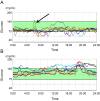Insulinoma Presenting with Reactive Hypoglycemia: Evaluating the Effect of Tumor Resection via Continuous Glucose Monitoring
- PMID: 28943561
- PMCID: PMC5725862
- DOI: 10.2169/internalmedicine.8766-16
Insulinoma Presenting with Reactive Hypoglycemia: Evaluating the Effect of Tumor Resection via Continuous Glucose Monitoring
Abstract
A 71-year-old woman previously diagnosed with reactive hypoglycemia was transferred to our emergency unit because of loss of consciousness. Her plasma glucose level was 27 mg/dL, and continuous glucose monitoring (CGM) revealed postprandial asymptomatic hypoglycemia. A hypervascular tumor was identified via computed tomography in the distal pancreas, and the diagnosis of insulinoma was confirmed using the selective arterial calcium stimulation test. Although no episodes of hypoglycemia were observed during CGM after resection, a pathological examination identified regional lymph node metastasis. It is important to consider insulinoma as a cause of postprandial hypoglycemia, and CGM is useful for evaluating treatment outcomes.
Keywords: continuous glucose monitoring; insulinoma; metastasis; postprandial hypoglycemia.
Figures




Similar articles
-
A rare case of insulinoma presenting with postprandial hypoglycemia.Am J Case Rep. 2014 Nov 9;15:488-91. doi: 10.12659/AJCR.891336. Am J Case Rep. 2014. PMID: 25381469 Free PMC article.
-
Glucose-responsive insulinoma in a patient with postprandial hypoglycemia in the morning.Intern Med. 2010;49(19):2123-7. doi: 10.2169/internalmedicine.49.3854. Epub 2010 Oct 1. Intern Med. 2010. PMID: 20930440
-
Insulinoma with six islet cell tumors associated with severe hypoglycemia.Intern Med. 2009;48(12):1041-6. doi: 10.2169/internalmedicine.48.1837. Epub 2009 Jun 15. Intern Med. 2009. PMID: 19525595
-
Sporadic insulinoma in a 10-year-old boy: a case report and literature review.JOP. 2014 Jan 10;15(1):53-7. doi: 10.6092/1590-8577/1925. JOP. 2014. PMID: 24413786 Review.
-
[Hypoglycemia caused by insulinoma in diabetes mellitus].Dtsch Med Wochenschr. 1988 Nov 4;113(44):1714-7. doi: 10.1055/s-2008-1067877. Dtsch Med Wochenschr. 1988. PMID: 2846254 Review. German.
Cited by
-
Continuous glucose monitoring in a patient with insulinoma presenting with unawareness of postprandial hypoglycemia.Endocrinol Diabetes Metab Case Rep. 2023 Sep 28;2023(3):23-0056. doi: 10.1530/EDM-23-0056. Print 2023 Jul 1. Endocrinol Diabetes Metab Case Rep. 2023. PMID: 37767703 Free PMC article.
-
Spontaneous hypoglycemia: should we mind the gap? Long-term follow-up of healthy people who met Whipple's triad criteria.Hormones (Athens). 2024 Sep;23(3):447-455. doi: 10.1007/s42000-024-00542-1. Epub 2024 Mar 8. Hormones (Athens). 2024. PMID: 38457064 Free PMC article.
-
Insulinoma Unmasked: A Continuous Glucose Monitoring-Fueled Journey.Curr Oncol. 2024 Sep 14;31(9):5452-5461. doi: 10.3390/curroncol31090403. Curr Oncol. 2024. PMID: 39330031 Free PMC article.
-
Insulinoma presenting with postprandial hypoglycemia and a low body mass index: A case report.World J Clin Cases. 2020 Sep 26;8(18):4169-4176. doi: 10.12998/wjcc.v8.i18.4169. World J Clin Cases. 2020. PMID: 33024775 Free PMC article.
-
Clinical and genetic analysis in a family with familial renal glucosuria: Identification of an N101K mutation in the sodium-glucose cotransporter 2 encoded by a solute carrier family 5 member 2 gene.J Diabetes Investig. 2020 May;11(3):573-577. doi: 10.1111/jdi.13157. Epub 2019 Nov 1. J Diabetes Investig. 2020. PMID: 31584752 Free PMC article.
References
-
- Service FJ, McMahon MM, O'Brien PC, Ballard DJ. Functioning insulinoma-incidence, recurrence, and long term survival of patients: a 60-year study. Mayo Clin Proc 66: 711-719, 1991. - PubMed
-
- Placzkowski KA, Vella A, Thompson GB, et al. . Secular trends in the presentation and management of functioning insulinoma at the Mayo Clinic 1987-2007. J Clin Endocrinol Metab 94: 1069-1073, 2009. - PubMed
-
- Heller SR, Cryper PE. Reduced neuroendocrine and symptomatic responses to subsequent hypoglycemia after 1 episode of hypoglycemia in nondiabetic humans. Diabetes 40: 223-226, 1991. - PubMed
-
- Sapountzi P, Charnogursky G, Emanuele MA, et al. . Case study: diagnosis of insulinoma using continuous glucose monitoring system in a patient with diabetes. Clinical Diabetes 23: 140-143, 2005.
-
- Baldeweg S, Hope S, Tibbals J, et al. . Use of continuous glucose monitoring system in the medical management of insulinoma. Endocrine Abstracts 6: DP23, 2003.
Publication types
MeSH terms
Substances
LinkOut - more resources
Full Text Sources
Other Literature Sources
Medical

